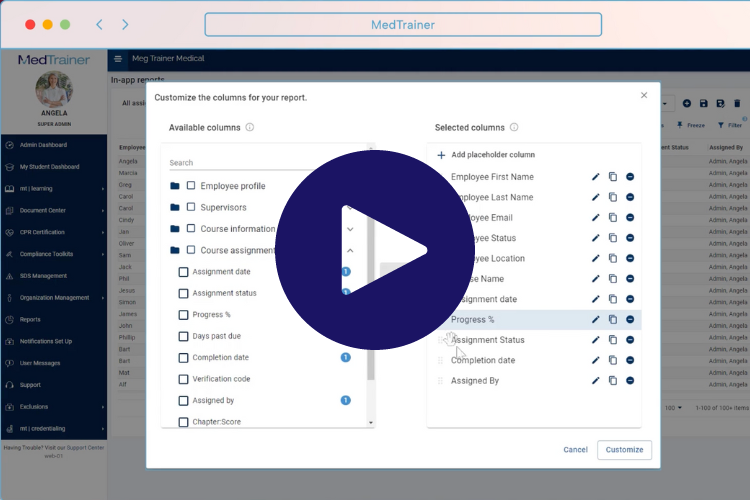Every time a patient seeks care — whether with their primary physician, a specialist, or for emergency care — that visit generates an incredible amount of data. In the days before healthcare digitization, everything was written down by hand and stored disparately. Today, thanks to electronic health records (EHRs), providers are able to capture more data than ever before — and centralize it all in one place.
EHRs bring together not only relevant patient data, but also historical patient data, for a comprehensive overview of that person’s health profile. They also enable providers to make better assessments and recommendations, and create a digital paper trail that follows patients from provider to provider. In short, EHRs have transformed healthcare for the better.
Let’s take a closer look at EHRs: what they are, how they work, and what it means to use them in a safe and compliant manner.
What Is an Electronic Health Record (EHR)?
An electronic health record is a digital version of a patient’s medical record. It’s a comprehensive collection of health information, stored and managed electronically. EHRs contain a wide range of data related to a patient’s health, including:
- Medical history
- Diagnoses
- Medications
- Allergies
- Immunization records
- Laboratory test results
- Radiology images
- Other relevant clinical information
The purpose of an EHR is to facilitate the exchange of health information among healthcare providers, allowing for better coordination of care and improved patient outcomes. It provides a centralized and accessible platform for healthcare professionals to view and update patient information, helping to ensure that all involved parties have access to accurate and up-to-date data.
EHRs vs. Traditional Medical Records
EHRs offer numerous advantages over traditional paper-based records. They allow for faster and more efficient record-keeping, eliminate the need for physical storage space, reduce the risk of lost or misplaced records, and enable easy retrieval of information. EHRs also support clinical decision-making by providing access to decision support tools and clinical guidelines.
There’s also an element of improved communication with EHRs, since patients can also access them. When patients have their health information, they’re more empowered to participate in their own healthcare journey, and more likely to see better outcomes as a result.
Finally, continuity of care is a major improvement over traditional medical records. Health information travels with patients wherever they go, to inform care at every stage of their journey. More than that, there’s less chance of records being lost or damaged. Better record-keeping adds up to better insights, which begets better results over a patient’s healthcare journey.
What Is the Difference Between an EHR and an EMR?
The terms Electronic Health Record (EHR) and Electronic Medical Record (EMR) are often used interchangeably, but they have slightly different meanings.
- An Electronic Medical Record (EMR) is a digital version of a patient’s medical record that is maintained within a single healthcare organization, such as a hospital or a physician’s office. It contains the patient’s medical and treatment history within that specific organization, including diagnoses, medications, test results, and other clinical information. EMRs are primarily used for documentation and patient tracking within a particular healthcare facility.
- An Electronic Health Record (EHR) is a more comprehensive and interconnected version of an EMR. It goes beyond the boundaries of a single healthcare organization and encompasses a broader view of a patient’s health information. An EHR includes data from multiple healthcare providers and systems. It enables the seamless sharing of patient information between hospitals, clinics, pharmacies, laboratories, and other healthcare entities involved in the patient’s care.
While an EMR is focused on the internal operations of a specific healthcare organization, an EHR supports the exchange and accessibility of health information across multiple organizations, promoting better continuity of care and coordination.
Is Compliance Software the Same as an EHR?
Compliance software and an Electronic Health Record (EHR) aren’t the same thing. They serve different purposes within the healthcare industry.
While compliance software may be used in conjunction with an EHR to help healthcare organizations ensure compliance with regulations and standards, they are distinct tools with different functions. Compliance software provides tools and functionalities to manage education, credentialing, and compliance activities, whereas an EHR is focused on the storage and management of patient health information.
Compliance software typically includes features such as policy management, online incident reporting, and staff training to help healthcare organizations maintain compliance. It helps ensure that the organization operates in accordance with laws, regulations, and guidelines related to patient privacy, data security, billing practices, documentation, and other compliance areas.

See the benefits of compliance software in less than 2 minutes.
Does an EHR Need to be HIPAA Compliant?
Because it deals with protected health information (PHI), an Electronic Health Record (EHR) needs to be HIPAA compliant. When using an EHR, providers must adhere to the HIPAA Privacy Rule and the HIPAA Security Rule. The Privacy Rule establishes the standards for the use and disclosure of PHI, while the Security Rule outlines the requirements for protecting the confidentiality, integrity, and availability of electronic PHI (ePHI).
To achieve HIPAA compliance, EHR systems must include various safeguards and measures to protect the privacy and security of patient health information. These may include access controls, encryption, audit trails, data backups, employee training, and policies and procedures to address HIPAA requirements.
It’s important for covered providers to select EHR vendors or software solutions that specifically offer HIPAA-compliant features. Additionally, organizations must implement their own administrative, technical, and physical safeguards to ensure compliance with HIPAA regulations when using an EHR.
How Compliance Training Improves EHR Use
EHR benefits both patients and providers however, there are also risks to consider — most of which stem from non-compliance with regulations like HIPAA. While most EHRs offer safeguards to protect PHI, the onus is on healthcare organizations to offer compliance training that educates their staff on best practices for handling PHI.
A modern learning management system (LMS) offers all the HIPAA courses you need (MedTrainer has more than 20 HIPAA-related courses), plus you have the ability to upload or create your own trainings. Maybe you have location-specific policies or procedures on which employees need to be trained. Or maybe you want to create a course specifically on using your organization’s EHR. All of this is possible with a robust LMS.
